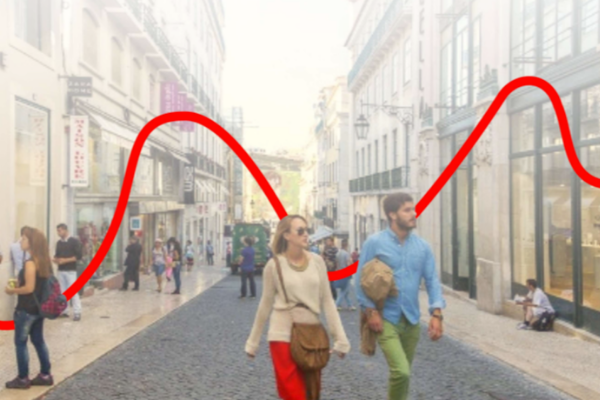
After analysing the most recent report drawn up by the REDUNIQ Insights n the 4th week of deconfinement, the most noteworthy feature is the extremely positive evolution of the economic indicators for Traditional Food Retail. Between 24 and 30 May, this sector, also known as proximity retail (neighbourhood grocery stores, for example), recorded a growth of 28% in turnover and an increase of 13% in the number of transactions compared to the previous week. first week of deconfinement thus establishing itself as the economic area that has grown the most since the start of the Covid-19 pandemic in Portugal.
The increase in the figures for transactions and invoicing also spreads to the sector's average ticket (average value of each purchase) when compared to pre-pandemic levels. While at that time the average ticket was 18.51€, last week it was 21.03€, a "clear reflection of the normalisation of neighbourhood life", as stated in the report from the knowledge solution at REDUNIQ. It should be noted that between the 2nd and 3rd week after the reopening, Traditional Food Retail had already seen an increase of 19% in the number of transactions and in its turnover.
Hyper & Supers vs. Traditional Retail | Billing Evolution
In contrast to this phenomenon are hypermarkets and supermarkets. These domains are still recording a number of transactions below what they were able to achieve before the pandemic. However, these figures show a favourable evolution with last week accumulating a number of transactions 19% lower than the pre-pandemic figures, as opposed to the 23% recorded at the end of the third week of lockdown.

Restaurants | Turnover & Active Points of Sale
In the spotlight continues to be Restoration. After the data from the 3rd week of reopening indicated an increase of 60% in the sector's turnover due to the opening of 65% more establishments at the end of the period between 24 and 30 May, the figures indicate that on Saturday 30 May alone, the restaurant sector reached 82% of the pre-pandemic average daily turnover and is, overall, operating at almost 80% of the levels of the beginning of March.
Active points of sale almost doubled (in the case of REDUNIQ there were around 4,500 that restarted activity), having gone from levels equivalent to around 40% from the starting point to around 80% of that figure. In the case of cafés and restaurants, the percentage of establishments open to the public now stands at 77%.
As was the case in some of the sectors analysed in the REDUNIQ document, the "weekend" effect was impressive, with demand and turnover levels doubling compared to weekday figures. It is also worth emphasising that the recovery observed is explained by the cumulative effect of lunch and dinner performance which, according to the report, is "yet another symptom of daily life realigning itself".

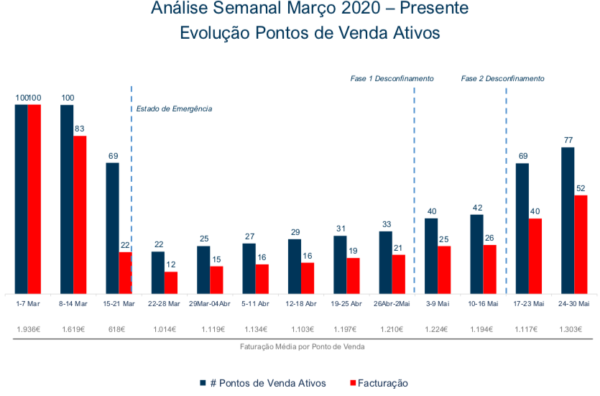
Gasoline companies | Evolution of invoicing
While Traditional Food Retail and Restaurants have seen sharp rises in the volume of transactions and turnover, petrol stations are not far behind. This sector's turnover has been growing in line with the upturn in the mobility of the population and companies. In terms of figures, from the second to the third week of lockdown, petrol stations saw a 14% increase in turnover, and on 23 May they reached around 90% of the levels invoiced in the pre-Covid-19 period for the first time since the end of the State of Emergency.
After four weeks of deconfinement, and with the 100% system now operational, new levels of mobility are being reached. Invoicing has now doubled compared to the minimum point and two thirds of the loss has already been recovered.

Home Appliances & Technology | Billing Evolution
In relation to other economic sectors, the report also presents the evolution of Household Appliances & Technology, Health and Fashion.
Regarding the former, REDUNIQ Insights shows that since the beginning of the lockdown, this area has maintained its turnover at higher levels than at the beginning of March (13% more in the last week of May), a fact that is explained by the importance that technology is playing in lives and jobs in times of Covid-19 (people have started to equip their homes with equipment for teleworking) and because it is a sector that is already well consolidated online, which has seen an increase in transactions during the lockdown period.
Technology is, in essence, stable and continues to be the category in which the coexistence of retail physical and e-commerce are a real increase in responsiveness. Among the tools that have helped retailers transfer their business to digital is the REDUNIQ@Payments. This solution allows economic agents to sell online and accept remote sales payments through a simple link in a simple, practical and secure way, even if it's at the selling on social media.

From Technology to HealthThe report highlights the 11% increase in the sector's turnover compared to the week of 17 to 23 May, for an estimated total of 82% of the turnover achieved before the pandemic. Finally, Fashion also grew from one week to the next (16% more), and now has a turnover equivalent to 50% of the total invoiced by the sector at the beginning of March. Remember that in the 3rd week of lockdown, the Fashion sector had grown by 113% compared to the previous week, and on Saturday 23 May reached a peak turnover of 68% of the base reference value (the total turnover reached in the first week of March), compared to the average of 44% of the base reference value observed throughout that week.
Turnover (Total Portugal)
In general terms, overall business turnover, according to the REDUNIQnow represents 80% of the total invoiced (73% between 17 and 23 May) in the period prior to the Covid-19 pandemic, an increase of 9.5% compared to the 3rd week of lockdown. The last week was also marked by the reopening of more than 2,000 points of sale, an increase of 5.5% compared to the previous week.
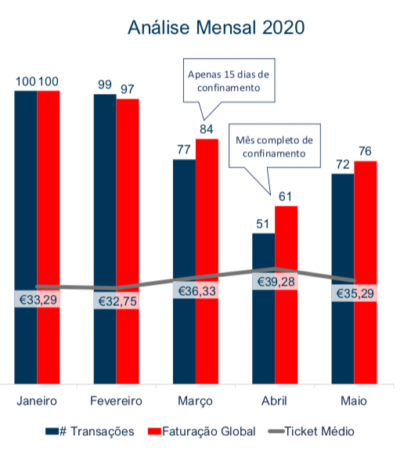

Analysing Billing by District
When the report's data is analysed by district, it can be seen that after the district of Portalegre reached the pre-pandemic billing figures in the third week of lockdown, it was the turn of the districts of Bragança, Santarém and Beja to cross that line. Close behind are the districts of Viana do Castelo (99%), Castelo Branco (99%), Setúbal (98%) and Évora (98%).

At the opposite end of the spectrum are districts and regions such as Lisbon, Madeira and Faro, which, having seen falls of 60%, still have little capacity to recover. These figures reflect the collapse of tourism, an important net contributor to these districts' retail systems (weight of Tourism at the start of March: Faro 39%, Madeira 36% and Lisbon 19%).
The differences between the larger districts such as Lisbon and Porto, Braga and Aveiro and most of the smaller districts can also be explained by the disparity in the "crises of income reduction" experienced in them, the study says.
Billing trends by nationality
Despite the drop in tourism, especially from abroad, the level of foreign turnover generally increased by 9.3% compared to the previous week, with the Autonomous Region of the Azores and the districts of Faro and Lisbon showing the most significant increases, with turnover growth of 29.5%, 13.8% and 13.1%, respectively.

Evolution of Contactless Billing (Total Portugal) and Evolution of the Weight of Contactless Billing in Total Billing
After a month of March with an increase of 113% compared to the same period in the previous year, and a month of April with an increase of 157% compared to the same month in 2019, the utilisation of the Contactless maintains the growth trend seen during the first few weeks of deconfinement.
So, while between 17 and 23 May, transactions made with this technology totalled a further 11%, a figure that represented a total of 22,95% of the total turnover of Portuguese businesses accepting REDUNIQ payments (59% higher than in the first week of March), in the fourth week of lockdown Contactless reached a turnover figure 77% above pre-Covid-19 levels, i.e. an increase of 11,19% compared to the previous week. Today, this payment method, which is possible via cards, smartphones and wearables, accounts for 23.3% of the total invoiced by Portuguese businesses.

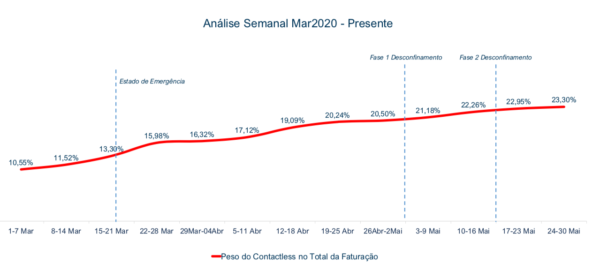
System Billing Evolution by Channel (Physical Store vs. Online)
In view of the growing need, evidenced by the figures, for businesses to adapt to the new forms of payment used by consumers, in particular the contactless card, REDUNIQ is providing merchants with a automatic payment terminal (physical or mobile POS) with contactless technology integrated so that the payment is processed securely and hygienically.
This Contactless PINIn addition to enabling faster transactions and reduce the risk of spreading the virusAs the payment is made without the card (or wearable) and payment terminal touching, it also allows the merchant to reduce cash handling costs, increase average transactions and give them the guarantee that the payment is actually made.
During the first half of the period analysed, after the 1st State of Emergency was declared, sales at physical outlets saw a progressive downward trend. On the other hand, during the same period, sales on the online channel accelerated significantly (increasing by around 20% compared to the starting point), which inexorably led to a historic increase in sales. online payments (160% more transactions compared to the same period in 2019).
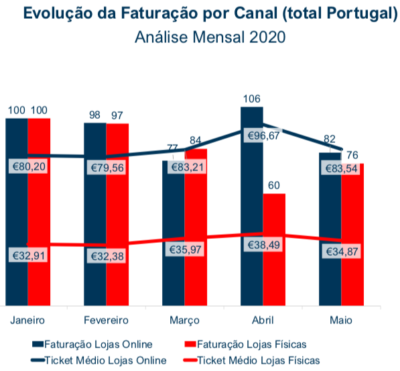

Conclusion
During this period of compulsory confinement, businesses reinvented themselves and moved from physical businesses to online businesses, with a 333% increase in the number of merchants signing up to online payment solutions when comparing the period between 13 March and 25 April 2019 and 2020. With the reopening, however, the opposite phenomenon occurred. Sales at physical points of sale increased and online sales fell, and are now close to 20% lower than they were at the start of March, with a consequent drop in the number of customers. e-commerce payments.
With the stabilisation of the "reopening" dynamics, a symbolic moment was observed: "society once again experienced the weekend" as a special moment of consumption. The REDUNIQ document notes that consumers, with more degrees of freedom, returned to the public space, normalised (as far as possible) their daily lives and recovered some of their shopper behaviour in physical points of sale.
To access the full report REDUNIQ Insights: Retail | Before, During and After Lockdown 03 June 2020 please click HERE
You can consult the other REDUNIQ Insights reports,


